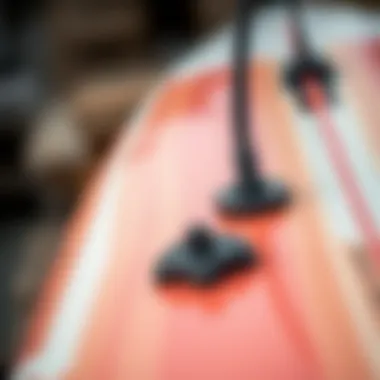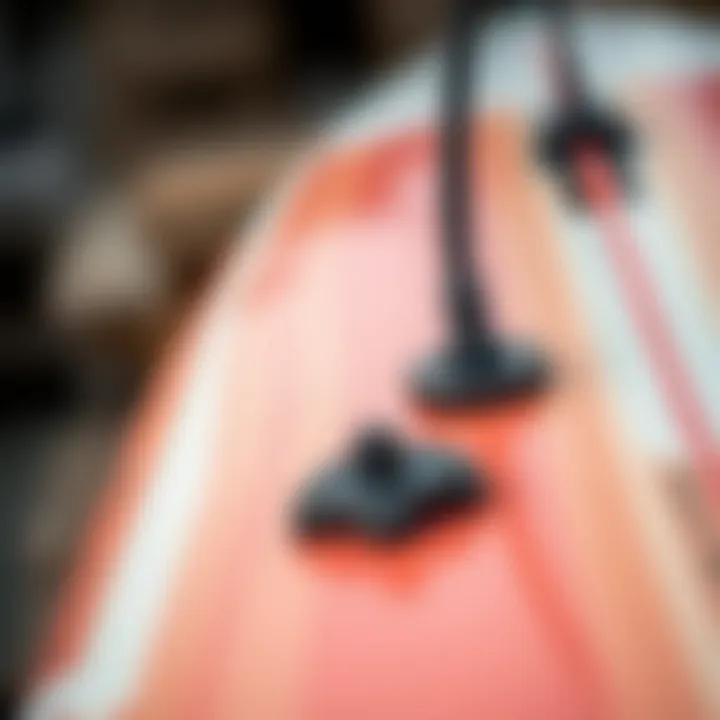Understanding Hydrofoil Surfboard Pricing


Intro
The world of hydrofoil surfing is rapidly gaining traction, attracting a kaleidoscope of enthusiasts from various backgrounds. It's not just the thrill of gliding above the water that captivates riders; it's also the variety of surfboards available that can confuse newcomers. With prices that vary as widely as the designs themselves, understanding what influences these numbers is crucial for making an informed purchase. Let’s wade into the currents of this subject together.
Gear Insights
When it comes to hydrofoil surfing, the gear is not just about looks — it's about performance, durability, and the joy it brings on the water. A hydrofoil surfboard is typically composed of several materials, each affecting the board's price. High density polystyrene, carbon fiber, and various types of epoxy and fiberglass can all be found in different models.
Latest Gear Reviews
There are many brands that dominate the hydrofoil market right now, each offering something unique. For instance, Naish and Fanatic have received rave reviews for their ultra-light designs that promise to elevate performance. They are often recommended for those who want responsiveness and stability — traits that can significantly affect your riding experience.
Another noteworthy mention is the Slingshot line, which often combines affordability with high-tech features. If you're a budget-conscious buyer, those models provide solid performance without burning a hole in your pocket.
Essential Gear for Beginners
For beginners venturing into this space, the right gear is essential, to make it a smoother learning curve. Here are a few pointers on what to look for:
- Board Size: A larger board provides more stability and is easier to learn on. A size between 5'0" and 5'6" could serve novices well.
- Foil Type: Beginners might want to stick with a flat plate or a high-aspect ratio wing to promote lift without excessive wobble.
- Safety Gear: A good impact vest and helmet are must-haves for newcomers. Falling is part of the learning process, and protection can minimize risks.
Making sense of hydrofoil surfboard pricing can feel daunting, but understanding these aspects brings clarity. It’s not just about which board looks snazzy; it’s about how it performs, how it’s constructed, and what you need as a rider. With careful consideration of these factors, each buyer can position themselves to make informed and value-laden purchases as they dive into the exhilarating world of hydrofoil surfing.
Preamble to Hydrofoil Surfboards
Hydrofoil surfboards have taken the surfing world by storm, offering a unique experience that elevates riders above the water surface. This innovation has stirred passion among water sports enthusiasts, and understanding their intricacies is crucial for anyone venturing into this arena. While traditional surfboards are constrained to the waves, hydrofoils enable surfers to glide seamlessly, providing not only an exhilarating ride but also new dimensions in wave riding that have never been seen before.
Definition and Functionality
At its core, a hydrofoil surfboard consists of a buoyant board with a hydrofoil mounted underneath. This hydrofoil, a long, wing-like structure, is submerged in water. As the rider gains momentum, the hydrofoil generates lift, causing the board to rise above the water's surface. This unique functionality allows for smoother rides over choppy waters and enables maneuvers that are typically challenging on a standard surfboard.
The mechanics might seem straightforward, but finesse is required to master the balance. Riders adjust their weight and posture to keep the board stable, turning the experience into a dance rather than just a sport. For those who have surfed before, this offers a completely different sensation—riding on a cushion of air rather than water, feeling like one is flying above the waves. This leaves out one important consideration: safety. With great innovation comes great responsibility, as this thrilling style of surfing requires a fresh approach to safety measures and understanding the environment where hydrofoils thrive.
Understanding hydrofoil surfboards is not just for the thrills; it’s about making informed choices when purchasing. The more you comprehend how these boards work and the factors that influence their pricing, the better equipped you are to make a worthwhile investment that captures the essence of this exhilarating water sport.
Evolving Technology in Hydrofoils
The evolution of hydrofoil technology has been nothing short of remarkable. Over recent years, advancements have led to lighter materials, better designs, and more efficient hydrodynamics. Initially, hydrofoils were bulky, primarily fashioned from heavy materials. However, innovative materials like carbon fiber and aluminum have emerged, leading to lighter, stronger constructions. This shift not only enhances performance but also significantly affects pricing.
Furthermore, the design of hydrofoils has become increasingly sophisticated. Improvements in wing shapes and sizes contribute to various performance aspects, such as stability, speed, and maneuverability. For example, larger wings provide more lift at slower speeds, making them preferable for beginners, while smaller wings cater to experienced riders looking for agility and speed.
These technological advancements also shape pricing structures in the market. A hydrofoil board with state-of-the-art design and materials can command a higher price tag, appealing to those who prioritize performance. Thus, understanding these evolving technologies is key for buyers to recognize what value they are getting for their money. Modern-day hydrofoils represent a blend of modern engineering and skill, making them not only a tool for riding but also a delicately crafted product that reflects years of innovation.
"The fusion of technology and artistry in hydrofoil surfboards is a testament to the evolution of the sport, illustrating how far we've come and the thrilling heights still to reach."
Key Components and Their Impact on Pricing
When venturing into the world of hydrofoil surfboards, understanding the core components that shape their pricing is crucial. The cost of a hydrofoil surfboard is more than just a number on a price tag; it reflects the intricate blend of materials, design principles, and performance capabilities that go into each board. Recognizing these factors not only empowers buyers to make informed decisions but also helps in appreciating the value of their investment.
Materials Used in Construction
The materials chosen for a hydrofoil surfboard can greatly influence its price point and overall performance. At a fundamental level, the composition of the board dictates its durability, weight, buoyancy, and responsiveness.
- Epoxy vs. Polyester Resins: Most entry-level boards are made with polyesters, which are generally cheaper, but they lack the same strength and weight benefits of epoxy. Epoxy boards, while pricier, offer better durability and a lighter weight. This difference can make or break a surf session, especially when carving through waves.
- Foam Core Variants: The foam core material impacts buoyancy and rigidity. High-density foams are often used in premium boards for added strength and performance. In contrast, lower-density options may suffice for casual riders but won’t support advanced maneuvers well.
- Fin Materials: Hydrofoil fins can either be aluminum or carbon fiber. Carbon fiber, being lighter and stronger, increases maneuverability but often comes at a greater cost. Meanwhile, aluminum fins offer solid performance for less but can weigh the board down.
Investing in higher-quality materials often pays off in the long run, as they not only enhance the lifespan of the board but also elevate the overall riding experience.
Hydrofoil Design Variances
Hydrofoil design is another pivotal factor influencing pricing. The shape, size, and configuration of the hydrofoil itself determine ride quality and stability.


- Wing Size and Shape: Larger wings provide more lift but can create drag, while smaller wings allow for quicker maneuvering. Finding the right balance can mean the difference between a smooth glide or a frustrating paddle out.
- Aspect Ratio: A high aspect ratio wing (long and narrow) is excellent for speed and efficiency, making it a favorite among experienced riders. Conversely, a low aspect ratio wing (short and wide) provides added stability and is better suited for beginners, reflecting a more affordable price point.
- Mounting Systems: Some boards come with adjustable mounting systems that allow riders to alter the foil's position. This versatility can justify a higher price, as it caters to a broader range of skill levels and rider preferences.
Every rider's needs vary based on personal preference and skill level, and understanding how these design features can improve or inhibit performance is essential to making educated purchase choices.
In short, the right materials and design can elevate a hydrofoil surfboard from a mere object to an instrument of endless adventure on the water.
By grasping the nuances of both materials and design, potential buyers can evaluate hydrofoil surfboards with a discerning eye, ensuring they select a product that will not only match their riding style but also stand the test of time against the elements.
Factors Influencing Hydrofoil Surfboard Prices
When it comes to hydrofoil surfboards, the price tag can vary as widely as the waves you might catch. Understanding the various elements that contribute to the pricing of these boards is essential for anyone considering a purchase, especially those new to the scene. Without a doubt, several critical factors come into play.
Brand Influence
One cannot ignore the heft of brand reputation in the surfboard market. Names like Naish or Slingshot carry weight; the reason being is simple—trust is built over time. A well-established brand often provides not only quality but also service after the sale. If you encounter a snag on the waves, having a customer service team that knows their stuff can make all the difference. However, with that trust comes a premium price.
Additionally, brand marketing can shape customer perception significantly. For instance, a board wrapped in flashy advertising might appeal to those looking to show off. It's a bit like the difference between driving a sleek Tesla and an anonymous sedan; one turns heads while the other gets you from A to B without much fuss.
Market Demand Dynamics
Market demand also plays a critical role in determining prices. If hydrofoiling becomes a hot trend, prices can surge similarly to how concert tickets might skyrocket for a favorite band. Limited releases or high demand can cause specific models to become quite pricey.
Another aspect to consider here is the seasonal nature of surfing products. Generally, prices might dip during off-peak seasons as retailers look to clear inventory; conversely, expect higher prices when demand is at its peak, usually during summer.
- Current Trends: Following surf culture closely can pay off. Observing what's trending can help buyers find the right board at the right price.
- Availability: A limited supply of certain models can drive prices higher. It's akin to hunting down a vintage vinyl—rare finds come with a premium cost.
Technological Advancements and Their Costs
The advancements in hydrofoil technology are influencing prices like never before. New materials such as carbon fiber or advanced composites offer weight savings and improved performance but often come at a price. Simply put, better tech can mean heftier bills.
Hydrofoils have evolved from rudimentary designs to sophisticated machines, offering features that enhance lift and reduce drag. Boards that use state-of-the-art technology tend to attract a premium.
For instance:
- Adaptive Foils: These allow riders to modulate their ride experience, suiting different skill levels.
- Hydrodynamic Shapes: These improve speed and control, crucial for those serious about their performance on the water.
"Investing in technology may seem steep initially, but the benefits often justify the costs, particularly for dedicated enthusiasts."
All of the above factors intertwine to create a complex pricing structure, reflecting not only the materialistic aspects but also the cultural significance tied to these thrilling boards. Understanding these variables can equip buyers to make more prudent decisions as they dive into the hydrofoil world.
Price Range Overview
Understanding the price range of hydrofoil surfboards is vital for anyone looking to make a smart investment in this exhilarating sport. The prices vary widely, influenced by numerous factors such as brand reputation, material quality, and technological features. By grasping these price ranges, potential buyers can make informed decisions that align with their surfing needs and budget.
Entry-Level Hydrofoil Surfboards
Entry-level hydrofoil surfboards typically cater to newcomers or those who want to dip their toes into the water without breaking the bank. These boards often range between $800 and $1,500. They’re constructed with more affordable materials, which can be a great way for beginners to learn and gain experience without a hefty price tag. However, while they offer a good balance of performance and cost, some enthusiasts find that they lack the responsiveness and durability of higher-end models.
- **Pros of Entry-Level: **
- **Cons of Entry-Level: **
- Affordable pricing, making it easier for beginners to start.
- Lightweight and user-friendly designs help new riders adapt quickly.
- May not perform as well in challenging conditions.
- Often limited features compared to pricier options.
Mid-Range Options
Mid-range hydrofoil surfboards generally span from $1,500 to $3,000 and are geared towards more dedicated hobbyists. These boards often come with enhanced features, such as advanced materials and better foils, which can lead to improved performance. The quality-to-price ratio in this segment tends to strike a balance, making it a sweet spot for many users.
- What buyers can expect:
- Better durability and performance under varied conditions.
- More options in design and features, providing a degree of customization.


For instance, boards like the Slingshot Ghost, which falls into this category, provide a lightweight yet solid construction that allows riders to progress faster, even in rougher waters.
High-End Hydrofoil Surfboards
When it comes to high-end hydrofoil surfboards, expect to shell out between $3,000 to $6,000 or more. Top brands, such as Naish or Duotone, offer premium surfboards designed for pro-level performance. These boards are made from the finest materials, integrating the latest technological advancements to enhance speed, agility, and stability.
- Highlights of High-End Boards:
- Exceptional craftsmanship and cutting-edge design elements.
- Enhanced features that provide superior performance.
While these boards come with a price, they often retain good resale value, which might attract seasoned riders looking to upgrade. However, it’s essential for potential buyers to weigh their skill level against such a hefty investment before diving in.
High-end models might feel like throwing money down the drain for beginner or casual surfers, but for those who are serious about the sport, the right investment can open up a world of possibilities.
Comparative Analysis of Popular Brands
In the expansive world of hydrofoil surfboards, understanding the nuances between brands can mean the difference between an enjoyable experience on the waves and a frustrating one. This section serves to dissect the offerings of some of the major players in the hydrofoil market, drawing comparisons that will help potential buyers make informed choices. By looking closely at factors such as build quality, performance characteristics, and customer support, readers can grasp which brand aligns best with their individual surfing style and budget.
When entering the hydrofoil arena, familiarity with brand reputations and product reviews from fellow enthusiasts can go a long way. Brands often carry specific strengths, whether it’s exceptional craftsmanship, innovative designs, or comprehensive warranties. Let’s dive into two major competitors, Brand A and Brand B, and evaluate how they stack up against each other.
Brand A vs. Brand B
Brand A has established a strong foothold in the hydrofoil surfing community, recognized for its high-quality materials and robust designs. Their hydrofoil surfboards tend to come at a premium price, reflecting their commitment to durability and performance. Enthusiasts often rave about the stability and response of Board A, making it a preferred choice for riders who prioritize precision and control.
On the other side of the spectrum, Brand B offers a more budget-friendly approach without compromising on essential features. Their boards are often seen as great entry points for new surfers who want to dip their toes into the hydrofoiling experience. While Brand B may not boast the same level of performance as Brand A, they do offer admirable responsiveness and easier maneuverability, appealing to those who prioritize a balance of fun and affordability.
In direct comparison, here are some key points to consider:
- Price Range
- Material Quality
- Performance
- Brand A: Generally priced higher, targeting serious surfers
- Brand B: More accessible pricing for novice surfers
- Brand A: Premium materials for enhanced durability
- Brand B: Solid but less elite material choices
- Brand A: Known for stability and fine-tuned designs
- Brand B: Good all-round performance, easy to control
Both brands offer unique selling propositions that cater to different segments of the surfing population. Evaluating personal preferences—such as skill level, intended use, and budget—will ultimately guide the decision-making process for first-time buyers.
Brand C: Price and Performance
Brand C represents a fascinating case, striking a balance between budget and performance. Often positioning itself as a middle-ground option, it appeals to both budding enthusiasts and seasoned surfers. The pricing structure of Brand C reflects careful engineering that doesn’t sacrifice quality while being attentive to an emerging market of cost-conscious buyers.
What’s compelling about Brand C is its approach to technology. By integrating features typically found in higher-end models at a more reasonable price point, this brand has garnered praise for offering value without the premium tags.
In terms of performance, Brand C claims to offer an intuitive ride. Many purchasers share their experiences of feeling comfortable as they tackle both flat waters and choppy waves. This versatility has positioned it as a popular choice for those who venture into various riding styles.
For those contemplating an investment in a hydrofoil surfboard, exploring Brand C's offerings can reveal surprising benefits, particularly for those not wanting to fork over the top dollar but still seeking quality performance.
"Ultimately, finding the right hydrofoil surfboard comes down to understanding not just the brands, but also what fits best with the individual’s own riding style and budget."
By analyzing these competitive brands, surfers can better navigate the complex landscape of hydrofoil surfing, making choices that not only satisfy their immediate needs but also pave the way for future adventures on the water.
Understanding Value for Money
In the realm of hydrofoil surfboards, grasping the concept of value for money is more than just a savvy shopping tactic; it's about aligning your investment with your needs and expectations. Hydrofoils come in different shapes, sizes, and functionalities, which makes it essential for buyers to assess features and pricing effectively. The beauty of hydrofoiling lies not just in the thrill of riding the waves, but also in the gear you choose to get there. With prices ranging from budget-friendly options to premium models, understanding what constitutes value can make a significant difference in your riding experience.
Making an informed decision requires considering several elements:
- Performance Features: Each hydrofoil has its own set of performance characteristics, such as lift, stability, and responsiveness. A high price tag doesn’t always equate to superior performance, so it’s crucial to compare these features closely.
- Durability: Investing in well-constructed materials can save you money in the long run. Cheaper models might promise immediate satisfaction but can leave you high and dry when they don’t withstand the wear and tear of consistent use.
- User Feedback: Exploring reviews and rider experiences can offer valuable insights into a product’s functionality and durability. Community input can guide you through the murky waters of choice.


"Investing a bit more initially might pay off with years of reliable fun on the water."
Ultimately, recognizing the interplay between features and costs allows you to make a choice that fits your style and budget.
Evaluating Features against Price
When it comes to picking a hydrofoil surfboard, not all that glitters is gold. Comparing features against price is an exercise in discerning what’s truly necessary for your riding adventures. Maneuverability, lift, and weight are just a few aspects that can affect pricing. Consider the following key areas:
- Wing Design: Different wing shapes and sizes provide varied levels of lift and drag. Specific designs are tailored for particular conditions—big waves or flat water. It’s important to understand which wing style aligns with your riding goals.
- Mast Height: A higher mast allows for greater clearance over waves, while lower masts might be easier to handle for beginners. Higher performance often comes at a cost; evaluate how this impacts your price range.
- Board Construction: The materials used play a critical role in overall performance and price. A lightweight board made of durable materials can boost your experience but may command a higher price.
By analyzing these features and their associated costs, buyers can make decisions that won't leave them feeling like they’ve bitten off more than they can chew.
Resale Value Considerations
Thinking about resale value might seem trivial when you're excited about a new hydrofoil surfboard, but consider this: the right choice now could mean financial advantages in the future. Certain brands and models retain their value better, creating an opportunity for savvy buyers to recoup part of their investment. Here are a few factors to consider:
- Brand Reputation: Some brands like Axis and Slingshot have a solid track record in the hydrofoil community. Products from these companies often maintain their worth and are sought after by other enthusiasts.
- Condition of Gear: Keeping your board and foil in excellent shape—free from scratches and dents—can significantly enhance its resale potential.
- Market Trends: Keep an eye on the market. If a particular type of hydrofoil gains popularity, the value may increase. Similarly, models falling out of favor might quickly depreciate.
In essence, keeping resale value in mind while making an initial purchase can turn out to be a wise move for budget-conscious riders who plan on upgrading down the line.
For further reading on economic factors in surfing gear, you might explore these resources:
- Wikipedia - Hydrofoils
- Britannica - Surfboards
- Discussions on Reddit about gear evaluations.
Recommendations for First-Time Buyers
Navigating the world of hydrofoil surfboards can be an overwhelming task for someone just dipping their toes into the sport. With many options and variables at play, it’s crucial for first-time buyers to make informed decisions that ensure a sound investment. This section emphasizes the importance of understanding what to look for when purchasing a hydrofoil surfboard to ensure that it aligns with your surfing goals and enhances your experience on the water.
Newcomers can often feel like they’re swimming in a sea of choices. It’s important to realize that not every board will suit every rider. Factors like skill level, intended use, and personal preferences will significantly influence the right choice. Ensuring that you prioritize essential features can significantly impact your enjoyment and safety. Here’s what to keep in mind:
Essential Features to Consider
When selecting a hydrofoil surfboard, consider the following key features that can drastically influence performance and overall riding experience:
- Size and Shape: The board's size affects stability and maneuverability. Typically, larger boards lend more stability, making them suitable for beginners, while smaller boards may provide more agility for advanced riders.
- Material Composition: Hydrofoil surfboards are made of various materials, generally ranging from foam composites to carbon fiber. Higher-end materials may cost more but can enhance performance and durability.
- Hydrofoil Design: The design of the hydrofoil itself is paramount. Beginners might want a lift-oriented foil that offers maximum stability, while seasoned surfers might seek design variations that optimize speed or trick capabilities.
- Weight Capacity: It’s essential to choose a board that can support your weight effectively. Each board comes with a recommended rider weight range, which is vital for maintaining balance and stability.
- Ease of Use: Look for features that enhance user-friendliness, like built-in grab handles or beginner-friendly foil setups that allow for easy setup and transitions while learning.
Considering these factors can empower first-time buyers to choose a board that complements their surfing style and paves the way for future skills development.
Where to Purchase Hydrofoil Surfboards
Once you have a grip on the features that matter most to you, it's time to look at where to make your purchase. Hydrofoil surfboards are available at various physical and online retailers, but the right environment can make all the difference. Here’s a breakdown to guide your purchase:
- Specialty Surf Shops: These places often provide knowledgeable staff who can offer tailored advice and let you physically inspect and test boards. They may even have demo programs to try before you buy.
- Online Retailers: Websites like Amazon and specialized sites such as TheHydrofoilStore.com offer a vast selection. Make sure that you thoroughly read product reviews and check return policies when buying online.
- Second-Hand Markets: Platforms like Facebook Marketplace or Craigslist can have great deals. There’s no harm in hunting for a gently used hydrofoil—it can save you a pretty penny! Just do due diligence to inspect for wear and tear.
- Local Surfing Communities: Engaging with local surfing forums, or Reddit’s r/surfing community, can be valuable for recommendations on where to buy. You might even find someone selling a board directly, cutting out middleman costs.
Successful purchase decisions stem from patience and research. Take your time to gather information before diving in.
Researching before making a purchase isn’t just about dollars—it’s about ensuring that your chosen hydrofoil surfboard will support you in progressing your skills while providing endless fun on the water. Choosing wisely will make your initiation into hydrofoil surfing a rewarding adventure.
The End
When it comes to hydrofoil surfboard pricing, a clear understanding of the components and market influences is essential. This conclusion synthesizes the insights shared throughout the article, emphasizing the salient factors that not only shape prices but also determine value.
Summarizing Key Insights
Navigating the world of hydrofoil surfboards requires more than just a glance at price tags. Here are some key takeaways:
- Material Matters: The choice of materials significantly impacts the overall cost. High-quality constructions may initially seem pricier but tend to offer durability and performance that can pay off in the long run. Whether it's carbon fiber or aluminum, each material brings its own set of pros and cons.
- Brand Reputation: Established brands often command higher prices due to their track record in reliability and innovation. However, this doesn't mean lesser-known brands can't offer good quality; it's about finding the right balance of brand trust and product quality.
- Technological Innovations: Advances in hydrofoil technology often lead to price increases. It's crucial to weigh the benefits of these innovations against their costs and consider how they align with your surfing skills and style.
- Resale Value: Some boards hold their value better than others. Keeping an eye on market trends and resale markets can inform decisions on which boards will be worth investing in.
- Market Demand: As hydrofoil surfing gains popularity, demand influences pricing. A surge in interest can ramp up prices, compelling buyers to act quickly.
"Investing in a hydrofoil surfboard isn't just about the buying price; it's about choosing the right product for your surfing journey."
These insights form the backbone of informed decision-making for prospective hydrofoil surfboard buyers, giving consumers the tools to evaluate options critically.
Final Thoughts on Investment
Ultimately, purchasing a hydrofoil surfboard is an investment in both quality and experience. A well-thought-out purchase can lead to years of enjoyment on the water. It's prudent to consider both your current level of expertise and your long-term aspirations in this sport. Here are some final considerations:
- Assess Your Skill Level: Choose a board that complements your skill level. For beginners, it may be wise to start with a more affordable option before diving into high-end models.
- Think About Usage: Are you planning to use the board frequently, or is it a hobby that may not see much action? This can determine whether you opt for a premium board or something more budget-friendly.
- Future-Proof Your Choice: Select a board that can grow with you. Look for features that allow for upgrades or add-ons over time, accommodating your growth in the sport.















